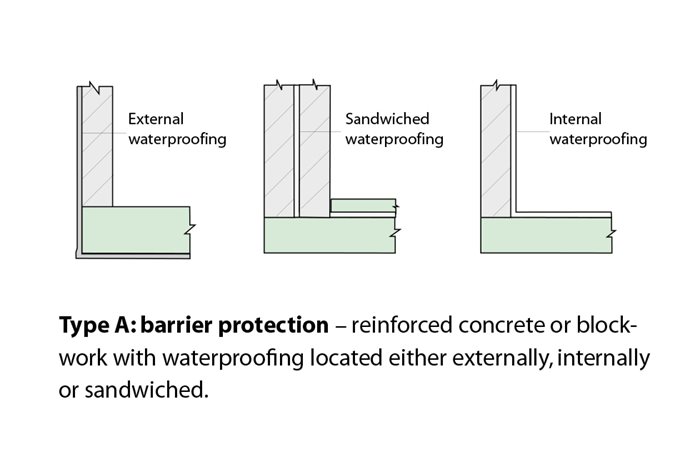Type A (Barrier) System

The watertightness of the Type A basement relies fundamentally on the effectiveness of the waterproofing system. With a high water table, any defects in the waterproofing barrier will allow water to penetrate and if the structural elements are permeable (e.g. masonry) will allow free water to enter the basement. If this water is not removed, the basement will fill to the level of the water table. Structural elements that are less permeable (e.g. concrete walls) which resist or lessen the occurrence of free water can extend the usage of Type A construction.
Since fundamental reliance is placed on the waterproofing system in Type A structures, account must be taken of the need to gain access if a defect occurs.
Externally applied systems may require subsequent excavation. However, locating the source of a defect in a system not continuously bonded to the substrate wall can be difficult.
An internal system makes accessing and remediating the defect more straightforward but consideration needs to be given to internal fittings.
Where the site is permanently free-drained, any defects in the system will allow moisture to move under capillary action (which is influenced by the amount of water resistance offered by the structural wall elements). Where the defect is small, this may result in some dampness in the structure, but will not necessarily show itself on the internal surface. However, any decoration or surface coating that acts as a vapour check will increase the risk of interstitial condensation and hence possible damage.
With a varying water table, significant water ingress through defects will occur only during storm or water-logged conditions and again will depend on the resistance of the structural elements. If the water table is high only briefly, the ingress might not be enough to show itself. The longer it stays high, the greater the risk of significant dampness or even partial flooding.
The incorporation of maintainable land drains can be used under appropriate ground conditions to achieve a situation where all moisture is under capillary action. Scheduled maintenance of land drains is required.
Further information is available from our guidance document Basements: Waterproofing